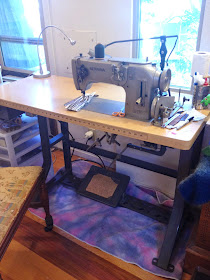But enough about me...
My most recent project was a leather fanny pack for my older daughter. Like me, she likes to keep her hands free, so she avoids carrying purses. She likes leather fanny packs instead. She has had a couple that worked pretty well for her, but she breaks the zippers on them because she stuffs them too full. So this time, instead of just buying her a new one (leather fanny packs are not cheap, even if you can find one you like!), I decided to make her one myself.One of her favorite fanny packs was from Libaire, a company in Berkeley, CA (search libaire.net for fanny pack). It's a great pack, elegant and well made of unlined sturdy leather, but she overstuffed it and eventually broke the zipper. Here is the original:
I copied the general design of the Libaire pack with its four zipper pockets, but I modified it, of course. I made a paper pattern for it that was a bit bigger in all dimensions. I also planned to add a lining to the main section of the bag that would include a few organizer pockets. My daughter has a set of stuff she always carries, such as headphones, highlighters, and a small pencil case, so I wanted to tailor the pockets just for her.
For materials I used four sturdy zippers I had salvaged from old jackets and backpacks, along with the remains of the same crocodile-embossed cowhide I used for a previous iPod case. I had fabric scraps left over from making a slip, so I used those for the lining. Once I made the pattern and cut out all the pieces for the new pouch and the lining, I had a nice pile of bits.
My mom recently gave me her old industrial sewing machine. It's a Bernina 217, almost 50 years old, and it can sew through pretty much anything. It has a heavy-duty clutch motor underneath the table, and the motor stays on, humming, the entire time you are working at the machine. As I was working on the project, I realized that the sound makes me feel warm and secure--I have a happy association with the humming sound from all the times my mom would work at the machine while I was playing nearby, or in bed, when I was a kid.
I sewed the triangle pockets onto the back panel of the pack, making sure the zipper slide was not hanging out in the seam allowance. The two triangle pockets are connected by the webbing strap at this point. Once the triangle pockets were sewn on, I could cut off the excess zipper length.
And then a miracle happened...
Once all the sub-assemblies were assembled, I sewed the whole thing together to the accompaniment of much swearing and a bit of rework. It seemed like a Moebius bag, and I'm not quite sure how it actually finally went together. I'll probably have to reverse-engineer it to make another one! At the very end, I cut the webbing strap and sewed on the buckle and slider. Here is the finished bag:
Here is a view of the lining with organizer pockets in the main section:
Here is the fanny pack in use. Stuffed, of course!

And of course, the obligatory dog shot with Lacey and Tulip:
Tulip figured she'd better make sure there weren't any goodies lurking in the bag. Something sure smelled interesting in there!













Nice job!
ReplyDeleteThanks for writing them tutorial. Now I see I need to scrounge for some sturdy zippers before I'm start sewing my leather purse. In the pictures of the side pieces, it looked like you did not leave much excess or a stop on the end of the zipper. Does the leather prevent the slide from pulling off?
ReplyDeleteYes, when you close the zipper slides on the side pockets, both go towards the main compartment. They stop when they run into the main compartment. Also, I did sew the seam right across the zipper, so that helps stop the slide too. The outer ends of the zippers have the little metal stops, though those might not be needed either because of the seams.
ReplyDelete